Discover the Heraldry within the Glass of Abbey Church
Featuring 23 armorial shields from the stained glass in the Abbey Church, these coats of arms span nearly 600 years of history. They include the arms of noble feudal families and royal houses. Heraldry denoted power and status and what better way of making a statement than have your coat of arms set in glass for perpetuity so people would be reminded to pray for you and your heirs. The language of heraldry includes ancient French terms like ‘or’ meaning gold and ‘argent’ which is silver. ‘Gules’ is red and ‘azure’ is blue.
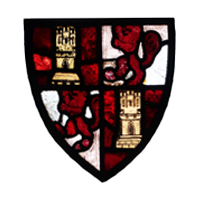
Name: Arms of CASTILE
Date: English, mid to late 14th century. Ettington, England
Description: The lions and towers of the Spanish kingdom of Castile on a trellis field of acorns and oak leaves, in white glass. This black and white floral background is known as ‘grisaille’ work.
Quarterly Gules a tower Or, Argent a lion rampant Gules.
Comments: The most prominent English connection to Castile in the Plantagenet period was Eleanor of Castile – the archetypal medieval queen. Born about 1241 in the Spanish kingdom of Castile to Ferdinand II and Joan, countess of Ponthieu, she was married in 1254 to Edward, son of Henry III, a political marriage to secure Gascony and Aquitaine.
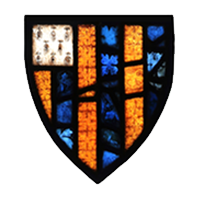
Name: Arms of SHIRLEY
Date: English, mid to late 14th century. Ettington, England
Description: The Shirley coat of arms on a trellis field of acorns and oak leaves, in white glass. This black and white floral background is known as ‘grisaille’ work.
Paly of six Or and Azure, a canton dexter ermine.
Comments: The Shirleys were related to the Earldom of Ferrers and one of the wealthiest noble families of medieval England, tracing their ancestry back to the Saxon thane Sewallis. Their home manor was at Ettington in Warwickshire and the first eight coats of arms shown here came from their chapel of the Holy Trinity and are pictorial links denoting historical marriages in a feudal world.
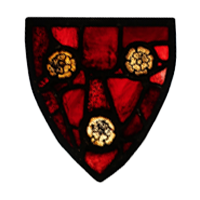
Name: UNKNOWN ARMS WITH THREE GOLD ROSES
Date: English, mid to late 14th century. Ettington, England
Description: Three golden roses on a red ground.
Gules three roses Or
Comments: Unidentified but possibly one of the more obscure members of the great Rollesley family of Derbyshire. Roses were a very common heraldic motif, but colour was often less important than the design.
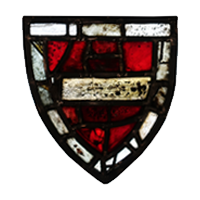
Name: Arms of ROLLESLEY
Date: English, mid to late 14th century. Ettington, England
Description: A red shield with a border and a bar of ermine, denoting noble rank.
Gules a fess ermine, a bordure of the last.
Comments: Rollesley (Rowesley) were from the county of Derbyshire. This ancient family held the Manor of Little Rowsley and took their name from this place as early as the reign of Richard I. The Rollesley family were actively marrying into good Midland noble families especially those with wealthy heiresses.
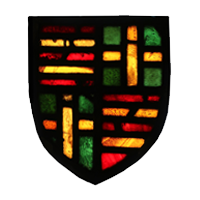
Name: Arms of HARCOURT quartering RISING
Date: English, 14th century. Ettington, England
Description: This colourful shield is placed on a grisaille trellis field of oak branches with leaves and acorns. A border of lions passant.
Gules two bars Or, quartering Rising, Vert a cross Or.
Comments: The famous French and English family of de Harcourt takes its name from the town of Harcourt in Calvados in Normandy and found themselves on opposing sides in the Hundred Years War at the battle of Crecy. The Rising family comes from Norfolk and trace their ancestry back to the Domesday Book of William the Conqueror.
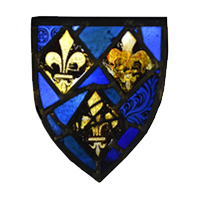
Name: Arms of FRANCE MODERN or CANTLOW (CANTELUPE)
Date: English, 14th century. Ettington, England
Description: Three lilies of France on a blue ground.
Azure, three fleur-de-lys Or
Comments: Two families carried this coat of arms. It is most likely to be that of France Modern, incorporated into the English royal arms in 1403 under Henry IV (1367-1413) but another candidate is that of Cantlow who was related to the Harcourts and the subject of a sensational murder in 1377 when Sir William de Cantelupe was murdered at the instigation of his wife and her lover, the local sheriff.
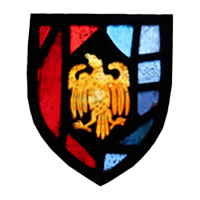
Name: Arms of MITTON
Date: English, late 14th century. Ettington, England
Description: The golden eagle on a ground of red and blue. The black lozenge is not part of the design but simply made the lead outlines easier to cut.
Per pale Gules and Azure an eagle displayed with wings inverted Or.
Comments: The arms of Mitton (also Milton) varied considerably over the medieval centuries; this coat of arms probably is that of the Fulwood branch of the Mittons of Shropshire.
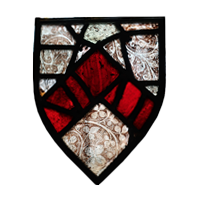
Name: Arms of TYES
Date: English, late 14th century. Ettington, England
Description: A red chevron on a white or silver background
Argent a chevron Gules.
Comments: Famous baronial family of German origin. Sir Henry Tyes rebelled against the excesses of Piers Gavaston, favourite of Edward II, and was executed in 1321.
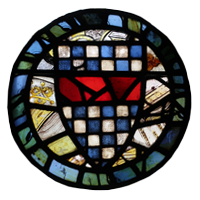
Name: Arms of CLIFFORD
Provenance: English, 14 -15th cent, probably Ettington, England.
Description: Arms of Clifford are normally shown with a chequered design in gold and blue, but here the glass painter has mistakenly used a white or argent chequer instead.
Chequy Azure and Argent a bar Gules.
Comments: This shield belongs to the famous warrior Cliffords, who came to England during the Norman Conquest and became feudal barons of Clifford Castle in Hertfordshire. Robert de Clifford fought against William Wallace and is immortalised in the famous Caerlaverock Roll of 1300 AD.

Name: Arms of UFFORD QUARTERING WILLOUGHBY
Date: English, 14 -15th cent, probably Ettington, England.
Description: Quartering is the heraldic term for linking two blazons, usually when a marriage occurs or when a noble inherited another title.
Quarterly gules a cross recerclée argent, sable a cross engrailed or.
Comments: The famous blazon of the great Willoughby family is shown linked to another noble house, the Uffords. In 1382, Robert Lord Willoughby (d.1395) inherited a large portion of the estates of his uncle William Ufford, Earl of Suffolk (d.1381) and as a result, was forced to incorporate the Ufford arms in seniority.
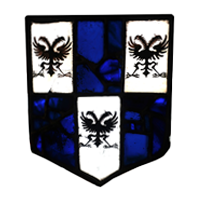
Name: Probably arms of GOYLYN
Date: English, 17th century or earlier. Perhaps from Winchester College
Description: Double headed eagles on white glass with dark blue (perhaps intended to be black) panels.
Paly per fess Argent a double eagle Sable.
Comments: A Sir John Goylyn had this blazon (but with the blue, black), and held a Manor from Sir Hugh Shirley in 1493.
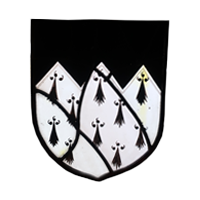
Name: Arms of EITHER TAYLOR OR GENT
Date: English. 17th century. It comes from the Chapel of Lincoln’s Inn, although the bearer was from Middle Temple, one of the other Inns of Court.
Description: Black indented shield with tassels representing sable, one of the two animal pelts used in heraldry.
Ermine a chief indented Sable
Comments: Removed from Lincoln’s Inn during conservation in 1920 after an air-raid in 1915. There are two possible contenders for this coat of arms, Richard Taylor of Clapham Manor, or the baronial Gents of Essex. Both had coats of arms displayed in the Inns of Court in 1690, but the armorial shield of Richard Taylor 1627, from the Chapel of Lincoln’s Inn is missing. Because of this, the shield most likely belongs to Taylor. Richard Taylor (c.1580-d.1641), claimed noble ancestry, but his father was a yeoman farmer. Nevertheless, he attracted wealthy patrons and was admitted to Lincoln’s Inn on 24 May 1600 and called to the Bar in 1607. He became Deputy Recorder for Bedford and was elected Member for Bedford in 1621 and sat until 1629 when Charles I ruled without Parliament.

Name: Arms of RICHARD WALTHAM
Date: English, Early 17th century (c. 1610). Lincoln’s Inn, The Chapel, London
Description: A painted shield using black enamel on clear glass
Sable three chevrons between three Suns in glory Argent.
Comments: This splendid coat of arms commemorates Sir Richard Waltham (1560-1632) of Trehill, who was Recorder of Exeter from 1628-1632. The Recorder was an important post, usually an experienced barrister or senior judicial officer of the City of Exeter in Devon. It was a position of prestige and power of patronage. The Recorder of a borough or city was often entrusted by the mayor and corporation to nominate its Members of Parliament.

Name: Arms of MOHUN
Date: English, Early 17th century. Lincoln’s Inn, The Chapel, London
Description: A painted shield using black enamel on a silver (yellow) stain
Or, a cross engrailed Sable.
Comments: The noble house of Mohun produced some of the cruellest and also most saintly barons of England. In the civil war between King Stephen and Queen Matilda (c. 1140) William de Mohun behaved with some savagery that Stephen mounted a campaign to end his cruelty. Reynold de Mohun – a good man – had a famous vision of his own death. Another Mohun fought with the Black Prince at Crecy and yet another was involved in duels, murder and kidnappings.
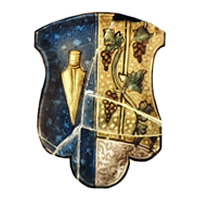
Name: Arms of GEMMINGEN-ADERSBACH
Date: German or Swiss, 17th century
Description: A painted shield that is incorporated into a small armorial window featuring a musketeer.
Per pale, Or, a vine twining, Azure a ploughshare Or.
Comments: This is the arms of the Lords of Gemmingen-Hornberg, in the modern German state of Baden-Wuttemberg and has now become the district’s coat of arms since 1890-1901. A grape growing district, the agricultural wealth of the Lords of Gemmingen is symbolised by a golden ploughshare.
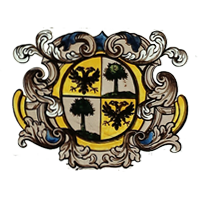
Name: BETROTHAL CERTIFICATE OF INA HARNSON
Date: 1725. probably Netherlandish or Flemish
Description: A scrolled coat of arms which has an inscription below reading “Et La Demlle Ina Harnson Son Espeuse 1725” (And the Lady Ina Harnson to marry, 1725)
Quarterly or a double eagle Sable, Argent a tree Vert.
Comments: Called ‘alliance panels’, these heraldic panels commemorated a marriage with the couple’s coat of arms, usually supported by a figure such as a maiden, soldier or wild man. This is a Continental blazon, possibly from the Gutteras family, which has this design, although the College of Arms could trace no link to the maiden Ina Harnson.

Name: Arms of ARAGON by Arnoult of Nijmegen
Date: Flemish, late 16th century. Antwerp, Grand Carmel Convent
Description: The shield was held by two winged putti in Roman legionary costume.
Or, four pales Gules
Comments: One of the most significant stained glass windows in the Abbey Museum’s collection, this lozenge shaped coat of Arms was made by the celebrated glass painter, Arnoult of Nijmegen, and commemorates the Spanish empire’s rule of the Netherlandish province of Flanders. The Habsburg rulers frequently made donations towards having their arms in famous churches and this window was made for the now destroyed Grand Carmelite convent in Antwerp.

Name: Arms of ARAGON AND SICILY by Sebold Beham
Date: German, Early 16th century. Nuremburg
Description: The shield was held by a semi naked woman in classical costume. The glass has been painted on a lemony silver stain with an enamel paint.
Comments: Sebold Beham was one of the most significant glass painters of Nuremberg in Germany, famous for his risqué subjects. The roundel is identical to a window made for the Duchess of Bavaria.
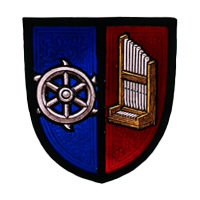
Name: Arms of ST KATHERINE OF ALEXANDRIA AND ST CECILIA by Heaton, Butler & Bayne
Date: English, late 19th century.
Description: The shield comes from a lancet window featuring a kneeling censing angel.
Per pale Azure the wheel of St Katherine Argent, Gules a portative organ Or and Argent.
Comments: A design from a Gothic Revival window by the famous stained glass makers of Heaton, Butler and Bayne of London, who made glass for Westminster Abbey. St Katherine’s martyrdom included use of a spiked wheel from whence comes the Catherine’s wheel of fireworks. St Cecilia was also a Roman martyr who is considered the patroness of music.
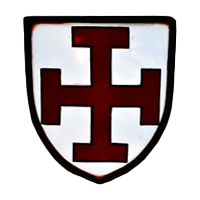
Name: Arms of ST MICHAEL’S COLLEGE by Heaton, Butler & Bayne
Date: English, late 19th century.
Description: The shield comes from a lancet window featuring a kneeling censing angel.
Argent, a cross potent Gules
Comments: This shield became the blazon of St Michael’s College in New Barnet, England, from 1930 to 1945, and again in Australia near to where the Abbey Medieval Festival is held.

Name: Arms of ENGLAND by Henry Holiday (1839-1927)
Date: English, late 19th century.
Description: The shield was held by a kneeling angel in a pink robe and features the royal lions of England and comes from a Gothic Revival window of the Angel Michael.
Gules, three lions passant guardant
Comments: Holiday was one of the leading artists of the famous James Powell and Sons studio in London. The three lions have been the personal arms of the English monarchs since 1198 in the reign of Richard I Lionheart, perhaps symbolising the triple role as King of the English, Duke of Normandy and Duke of Aquitaine.
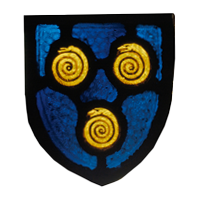
Name: Arms of ST HILD OF WHITBY
Date: English, late 19th– early 20th century.
Description: The shield comes from a window featuring St Hild.
Azure, three coiled snakes Or
Comments: St Hilda was a Northumbrian princess and became abbess of Whitby in 657 AD. Famous for her wisdom, she directed the critical Synod of Whitby in in 664 when the contentious date of Easter used by the Celtic Church was replaced by the Roman practice. The snakes featured are actually ammonites, a prehistoric shellfish found in large number in the chalk cliffs of Whitby. A flourishing trade occurred in the Middle Ages selling ammonites as Hild’s snakes turned to stone.

Order your Heraldry shirt on our shop now

Read more about the history of our Stained Glass in Glorious Glass

